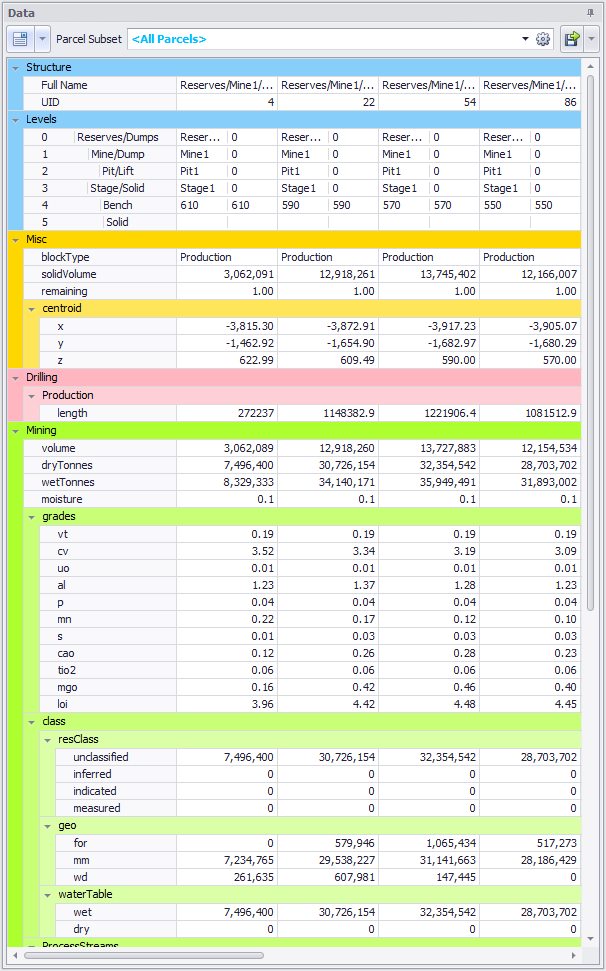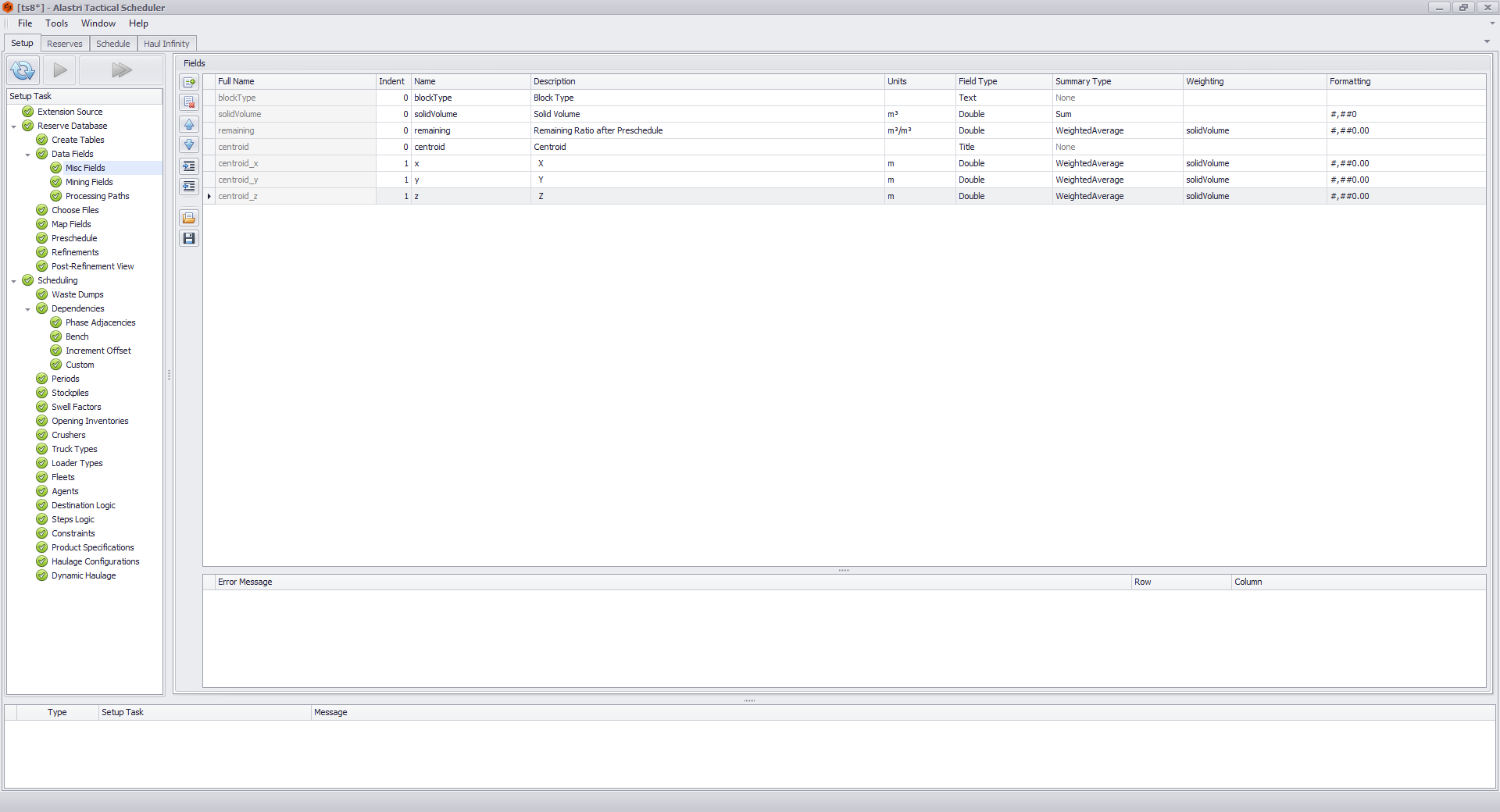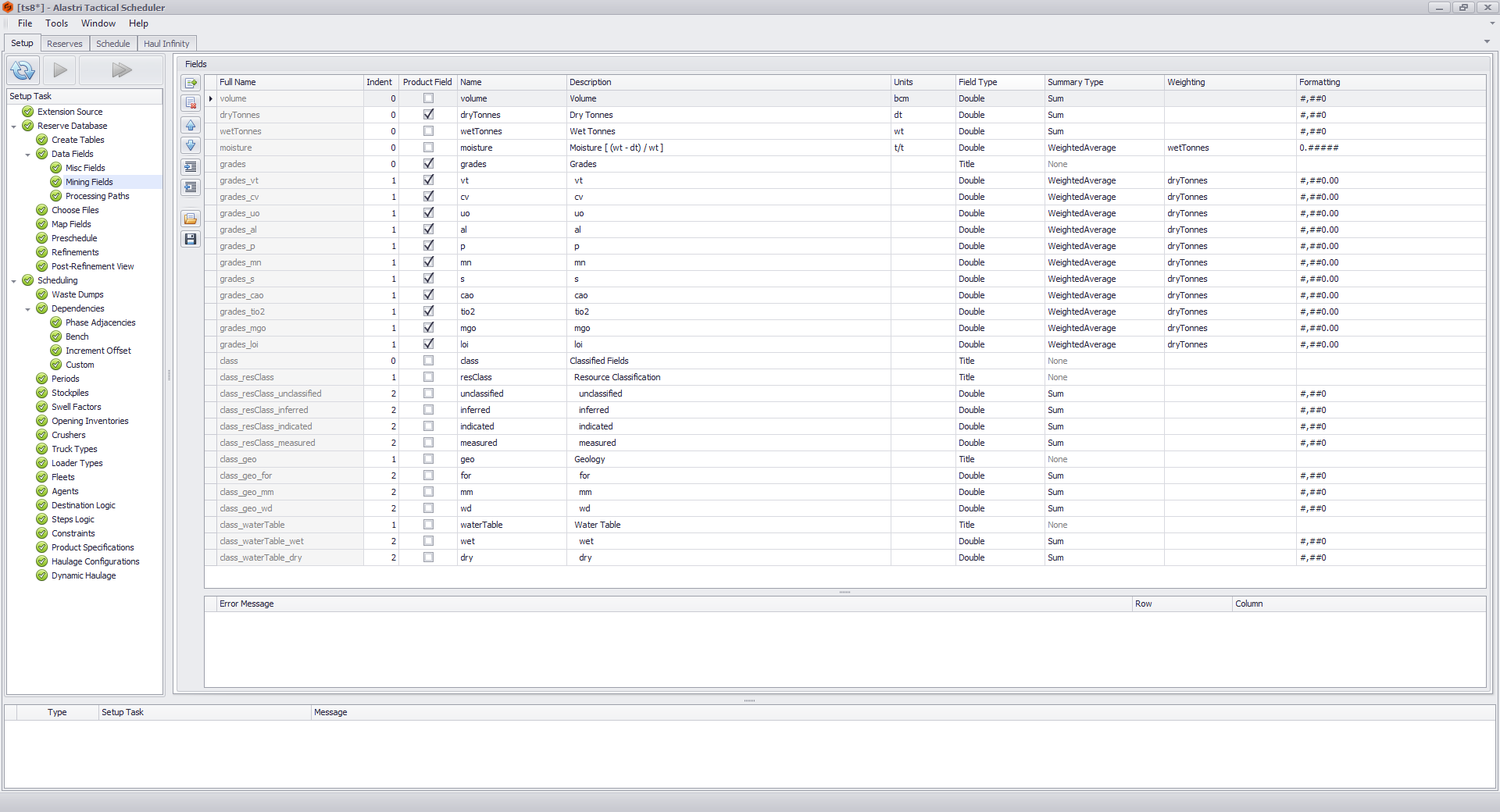ATS Data Fields
Data fields are created to hold values imported from the inventory files. These may include properties for each block, for the block contents, or for the drilling activities.
If values are not present in the inventory files, then they must be created by script in the Refinements step.
| Misc Fields | Block properties such as location, volume, depletion, etc. | |
| Drilling Fields | Hole properties such as length, volume, etc. | |
| Drill Hole Types | Hole types by diameter, pattern size, drill rig, rock type, etc. | |
| Mining Fields | Mining material properties such as density, moisture, tonnes and grades. | |
| Product Fields | Mining material properties that are measured at every processing path, point and product. | |
| Known Mining Parcels | Material types which may not be present in the inventory files but must be accounted for in stockpile opening inventories. | |
| Processing Paths | The unique paths to port (ie. wetPlant/dryPlant), the points at which they are measured (ie. rail/ship), and the different product types (i.e. lump/fine). | |
| Iron ore example: | 'wet_rail_fines' | |
| Gold example: | 'mill_site_gold' | |
Example layout of Misc, Drilling and Mining fields in the reserves.
Field Properties
Each field has a number of properties associated with it.
| Header Field | Usage |
|---|---|
| Full Name | Full address of the field, including parent Title fields (ie. class_waterTable_wet). |
| Indent | An indented field becomes a child of the Title field above it. |
| Product Field | A measure of product value such as tonnes, grades, and class. |
| Name | The name of the field that will appear in the reserves tables. |
| Description | A description of the field. |
| Units | Unit of measurement. |
| Field Type | Fields can be Title, Text, or Double (numeric). Indented fields must have a Title field as a parent. |
| Summary Type | When aggregating records, use Sum, WeightedAverage, Minimum, Maximum, or None. |
| Weighting | For weighted averages, use the weighting dropdown to reference another field. |
| Formatting | Choose how numeric fields are displayed. |
Misc Fields
Misc Fields are block properties such as block type, solid volume, depletion, and location.
Fields can be added, removed, ordered, grouped, imported and exported using the side button menu. Hover the mouse over each icon to see the command description.
Drilling Fields
This step is hidden if drills are disabled in the Configuration Options.
Drilling fields hold values for hole length, hole volume, and so on.
See Exercises: Drill Scheduling for more information.
Drill Hole Types
This step is hidden if drills are disabled in the Configuration Options.
Each pattern has one or more Hole Types to be drilled (for example: Production, Trim, Presplit).
If you intend to report blast meters by cost code, then each cost code must be a unique hole code.
See Exercises: Drill Scheduling for more information.
Mining Fields
The default Mining Fields are volume, dry tonnes, wet tonnes and moisture.
In addition to the defaults, we should add any block model fields that are present in the inventory files and which are relevant to scheduling. For example: product grades, contaminants, resource class, geological class, and water table class.
Any field which affects the commercial value of the material should be marked as a product field (i.e. tonnes and grades).
Fields can be added, removed, ordered, grouped, imported and exported using the side button menu. Hover the mouse over each icon to see the command description.
Known Mining Parcels
This step is hidden if Known Parcels are disabled in the Configuration Options.
This step is used to add additional material types to Tactical Scheduler that may not be present in the reserves inventory. This may include legacy materials on the stockpiles, or known material types that are predicted to be present in future iterations of the schedule.
This ensures that the parcel filters on Destination Logic, Steps Logic, Constraints and Product Specifications do not have to be updated every time there is a change in the reserves.
Processing Paths
The Processing Paths step is used to allow product fields to have different values depending on how they are processed, transported and screened.
- Processing streams are the mutually exclusive paths from pit to product.
- Product points are the changes to the product that occur along the transport path.
- Sub products are the split of product types at each point in each stream.
For example, the ratio of Lump to Fine sub products may change when handled from rail to ship, and the product grades are different through the wet plant vs the dry plant.
Example setup for an iron ore model
Example setup for a gold model




